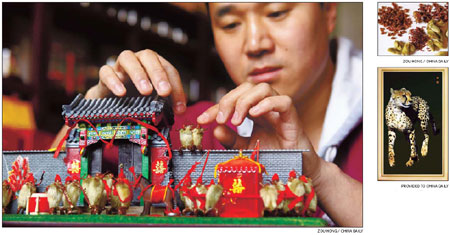People
Monkeying around with miniatures
Updated: 2011-03-09 08:04
By Wu Wencong (China Daily)
|
Clockwise from left: Xiao Jing, 30, creates a traditional Chinese wedding scene using monkey dolls. He learned the craft from his father, Xiao Zhanggui; The main raw materials that go into making the monkey dolls, cicada exuviae and magnolia bud; Hair embroidery of a leopard by Xiao Zhanggui, 56. |
 |
All too often when we think about traditional Chinese craftsmen, we imagine a man in his 50s - or at least 40s - with hoary hair and big glasses, who proudly presents his works with trembling yet dexterous hands.
Xiao Jing, however, is different from the stereotype. The 30-year-old craftsman is clean-shaven, with short-cropped hair and a coy smile. His craft is also somewhat different, as he makes monkey dolls.
The main raw materials for making the dolls are taken from traditional Chinese medicine (TCM): the shed skin of cicada, known as exuviae, and magnolia buds.
In TCM, cicada exuviae are used to treat laryngitis, while the tender buds of the magnolia, which are full of light yellow fluff and look very much like the body of a monkey, are used to cure rhinitis.
The craft has a history of more than 140 years and is said to have begun when a boy in a drug store made the first monkey doll to mock a storekeeper who had been treating him badly.
"Monkey dolls made by the two materials are cute and vivid when posed with human gestures," said Xiao. "With the help of other props, all kinds of scenes in daily life can be reproduced."
When METRO talked to him in his studio, Xiao was working on a small model of a traditional wedding ceremony featuring five dolls.
Although the materials he uses are simple, the craft was not easy to learn, he said, emphasizing that not everyone has the patience to sit all day long facing cicada exuviae and magnolia buds - especially men of his age.
"Many people have asked me how long it takes to make one doll, but it's really hard to tell," he said.
He pulled out several large boxes full of the raw materials. Different body parts made of cicada exuviae occupied three boxes.
"Treating the cicada exuviae itself is a lot of work," said Xiao. "After finding it, I need to cut it into small pieces to form the different body parts of the monkeys. Then trim the pieces again after cleaning and categorize them according to the shape."
And this is only the first process.
He will then carefully stick the cicada exuviae to the magnolia bud to form a complete monkey doll. The monkeys can show 24 gestures, as Xiao changes the direction and angles of the exuviae.
The next step is to paint the eyes and mouth of the monkey and to make the other props that will be required to complete the scene. The combination of monkey dolls and settings, which may include a table, a string of firecrackers, or a bridal sedan chair, form a complete piece of work.
The traditional scenes he likes to portray include setting off firecrackers, flying a kite and traditional Chinese weddings.
Xiao said he can reproduce any scenes using his monkey dolls. His latest work shows a typical day at a famous restaurant near the Workers Stadium, with a three-story building and hundreds of dolls.
"Sometimes it's boring facing these all day, but the culture has to be passed on," he said
Xiao used to work in the hospitality industry. Though he learned his doll skills from his father as a little boy, he did not take it up professionally until last year when he quit his job.
His father, named Xiao Zhanggui, can make even more complicated monkey dolls, including Beijing opera figures and musicians in a band.
Aside from making monkey dolls, Xiao's father is famous for another craft - hair embroidery.
With a history of more than 800 years, hair embroidery is a Mongolian folk art and was at its peak in Yuan Dynasty (1271-1368).
The craft is called embroidery, but it requires neither needles nor threads. The material used is the hair of animals, in most cases poultry and livestock, patterns are made by planting the hair on a piece of libret.
In the 1980s, Xiao's father started creating hair embroidery works. His masterpieces include a Tibetan mastiff and African lions.
"The hardest part of the craft is to make the transition of hairs in different colors look natural and real," the 56-year-old said. "Each animal usually has no more than five main colors. But if you look carefully, the color continues to change gradually all over its body."
Xiao Zhanggui now lives in the Inner Mongolia autonomous region and is focused on perfecting his hair embroidery.
At present Xiao Jing is not learning the art of hair embroidery as he wants to focus on making his monkey dolls.
"The art of making monkey dolls is on the verge of being lost. It is a craft that requires mastering four basic skills at the same time, which are art, biology, anatomy and making specimens."
Specials

Earthquake Hits Japan
A massive 8.8 magnitude quake hit the northeast coast of Japan on March 11,2011.

NPC & CPPCC sessions
Lawmakers and political advisers gather in Beijing to discuss major issues.

Pictures: quake aftermath
A massive earthquake hit Japan hard, leaving thousands dead.
